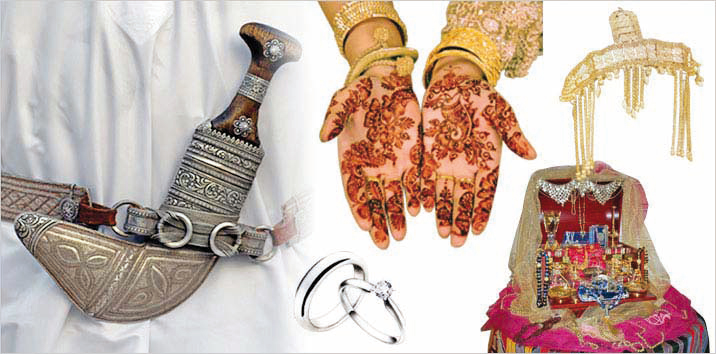

Maysa Saeed al Zubaidi -
“Culture is the arts elevated to a set of beliefs”, that is how the American novelist Thomas Wolfe sees a culture. However, I do believe that culture is too complicated to be explained in words, as it varies from one country to another.
Weddings, for instance, tell a lot about a country’s traditions and values. Some of these traditions are really odd but interesting. In Germany, for instance, the bride and the groom should cut a log to test their ability to work together.
In Oman, especially in Dhofar region, some unique traditions are followed in wedding celebrations as Omani weddings encompass three main stages ‑ engagement, wedding contract, and the wedding day.

Omani society is committed to its old traditions. The engagement requires the acceptance not only of the bride but her family’s viewpoint towards the groom as well. The engagement starts when the groom goes with his father and some of his relatives to the bride’s house. Thereafter having dinner they discuss Al Mahr, which is a particular amount of money that the groom must have to give to the bride in order to prepare her for the wedding.
Almahr in the past did not exceed RO 100 but nowadays it starts generally from RO 3,000 to RO 10,000 and it might even go more, especially among urban tribes. Some considerate bride families reduce Al Mahr amount taking into consideration the financial status of the groom and his family.
The other requirement for a groom is his manners and reputation in society. The bride’s family will not accept the groom’s request to marry their daughter until they are satisfied with his manners and reputation within his tribe.
Most families wait for three days or a week to give their final decision to the groom whether they accepted him or not to be a husband for their daughter. If the bride’s family agrees, along with Al Mahr, the groom family starts sending luxurious clothes, precious pieces of jewelry and expensive perfumes to the bride and her family and this tradition in Dhofar is known as Al Manani. This widely spread tradition reflects the groom’s happiness as the bride accepted him to be her husband.

The marriage contract is the second stage of every Dhofari wedding. This is usually done in a mosque and sometimes in the bride’s house where lots of people attend this ceremony.
Mainly halwa, an Omani sweet, and Arabian coffee are distributed to all the guests. During this ceremony, all men guests shake hands with the groom wishing him a happy marriage life. Furthermore, men perform traditional Omani dances like Al Haboot and Al Baraa as a way to express their happiness.
After around six months of the wedding contract, the wedding ceremony takes place. Women celebrate it elaborately either in a wedding hall or in the groom’s family house. On that day the bride wakes up early in the morning to go to a makeup artist which is called ‘muzahiba’ in order to prepare her for her big day.
Meanwhile, all the invited women also prepare themselves by putting makeup and doing a beautiful hairstyle. When the bride is ready she enters the wedding hall on the melodies of ‘Al-zafa’, written in the praise of the bride’s beauty and generosity of her family. Later, the bride’s brother takes her on his car to the groom’s house to start a new life with her husband.
Dhofar is still keeping the majority of its inherited traditions of celebrating weddings with minor changes in past rituals. Every Omani feels proud of this loyal commitment to their culture which is derived mainly from Islamic beliefs and values that makes Omani weddings distinctive.
Oman Observer is now on the WhatsApp channel. Click here



